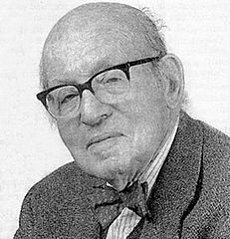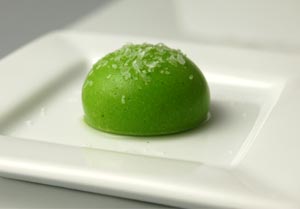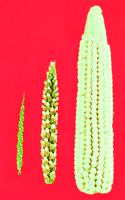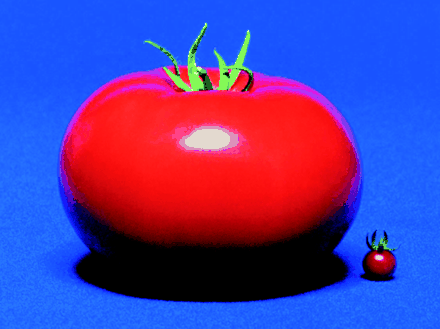CH391L/S13/Molecular Gastronomy: Difference between revisions
| Line 26: | Line 26: | ||
Noodles, raviolis, and any other shapes can be created out of various soups or other liquid | Noodles, raviolis, and any other shapes can be created out of various soups or other liquid recipes using sodium alginate and calcium. Flavored foam can be made using soy lecithin. Soy lecithin added to any juice and mixed rapidly will produce a frothy foam and can be used as a topping. Similar to sodium alginate, no heat is required for this [http://www.youtube.com/watch?v=z7mqvhg51BI process]. Dry ice can be placed in a recipe to spread the aroma of the food. Tapioca maltodextrin and salt are used to transform high-fat liquids into powders. For example olive oil, caramel, or even Nutella can be turned into a powder by this method but will melt back into oily substance if water is added to the powder. Ascorbic acid is used in bakeries to prevent apples from oxidizing on pies and such.More simple examples of molecular gastronomy are alcoholic drinks which can be separated into colorful layers based on the density of various alcohols in a drink. [7][6][13] | ||
| Line 39: | Line 39: | ||
*Clear raviolis | *Clear raviolis | ||
*Spherical Ice Cream Sundaes | *Spherical Ice Cream Sundaes | ||
* | * [http://www.youtube.com/watch?feature=fvwp&NR=1&v=vt34q4TVFyY Arugula Spaghetti] | ||
*Caviar | *Caviar | ||
Revision as of 09:27, 22 April 2013
Molecular Gastronomy
Introduction


Molecular gastronomy is a culinary science in which the chemical and physical properties of different foods are used in the creation of innovative and artistic foods.
Though not necessarily the first scientists to use molecular gastronomy, physicist Nicholas Kurti and chemist Hert This were the first to name this culinary art form “molecular gastronomy” in 1992. Other common names for molecular gastronomy include culinary physics and experimental cuisine. [2][5]
Nicholas Kurti was known as the “physicist in the kitchen”. His main science was physics and taught at Oxford University in the UK. Kurti’s favorite hobby was cooking. Kurti especially enjoyed pushing the limits of the culinary art with science. Hert This is a French physical chemist whose main research involves molecular gastronomy.[2][5]
Marie-Antoine Carême was one the first well respected culinary masters and recipe writers in France during the 1700s. She recognized important chemical and physical properties of foods when cooking. In the earlier ages of molecular gastronomy, around the 1700s, the coagulation of proteins, optimal heating rates, absorption of flavors, and other cooking techniques were observed and studied. Texture and flavor are directly affected by these different techniques.
Cooking Techniques
Basic spherification involves the creation of a thin membrane around a gelatinous liquid recipe. Sodium alginate is the main ingredient that gives the gelatinous properties to a liquid. When calcium is added to the mixture, a resilient gelatinous membrane forms around a spherical gelatinous ingredient. Sodium alginate is a tasteless thickener and an emulsifier often used in food industry which is derived from certain brown seaweeds.[14]

Reverse spherification is similar to basic spherification. A liquid food is frozen into spherical molds then placed into a sodium alginate and calcium bath creating a gelatinous membrane about the frozen sphere. The membrane forms about the frozen sphere before it is able to melt. The result is a water balloon-like product that can be seasoned a variety of different ways and even colored with food coloring. [13]
Noodles, raviolis, and any other shapes can be created out of various soups or other liquid recipes using sodium alginate and calcium. Flavored foam can be made using soy lecithin. Soy lecithin added to any juice and mixed rapidly will produce a frothy foam and can be used as a topping. Similar to sodium alginate, no heat is required for this process. Dry ice can be placed in a recipe to spread the aroma of the food. Tapioca maltodextrin and salt are used to transform high-fat liquids into powders. For example olive oil, caramel, or even Nutella can be turned into a powder by this method but will melt back into oily substance if water is added to the powder. Ascorbic acid is used in bakeries to prevent apples from oxidizing on pies and such.More simple examples of molecular gastronomy are alcoholic drinks which can be separated into colorful layers based on the density of various alcohols in a drink. [7][6][13]
Examples of foods made by molecular gastronomy:

- Soufflés
- Merengue
- Jell-O
- Pudding
- Pea Raviolis
- Clear raviolis
- Spherical Ice Cream Sundaes
- Arugula Spaghetti
- Caviar
Molecular Gastronomy by Genetic Engineering

Genetically Modified Organisms (GMOs) are becoming more common. Plants are genetically engineered to retain more nutrients, to produce brighter and more attractive pigments, to be more flavorful, to be seedless, to stay fresh longer, retain stiffness, grow larger, and to be “smart crops” in which they produce their own insecticides. Some crops that are genetically engineered include tomatoes, bananas, cotton, corn, and other fruits and vegetables. [4][8]
Pentadiplandra brazzeana is a fruit that contains a protein, known as brazzein, that is common in many other fruits and is responsible for sweetness. Brazzein protein is 2,000 times sweeter than sucrose in comparison by weight and has no structural homology to sucrose. The pSUMO-brazzein vector was used from pentadiplandra brazzeana to produce brazzein in E. Coli. SUMO fusion system allowed the production of brazzein in E. Coli. Proper folding occurred allowing for solubility and protein endurance over a wide range of temperature and pH. [1]
OSGATA vs. Monsanto
Monsanto is one of the leading companies in genetically engineered crops. Monsanto has created genetically engineered Agracetus cotton among many other crops. A problem Monsanto has with growing genetically crops is cross-pollination and contamination with other neighboring farms. Surrounding farms eventually become contaminated with Monsanto’s genetically modified seeds and naturally sell crops that were originally engineered by Monsanto. Monsanto has sued surrounding farms for plant infringement in the past. In order to prevent this from happening again farmers demanded assurance from Monsanto to not sue over cross-pollination. [9]
In 1985, Hibberd Case established the right to patent seeds, plants, and tissue culture. GMOs raise controversial questions such as who owns life? How can cross-pollination be prevented? Similar problems with patent problems to that of Monsanto have occurred with the Endless Summer Tomato. [8]
Steve Tansley, founder of Monsanto, provided an example of a tomato (Lycopersicon pimpinellifolium) which had been genetically engineered to retain more nutrients, have better shelf life, contain less toxins, and taste better. [8][15]

iGEM Projects
Harvard iGEM
Harvard iGarden includes plants genetically engineered to have various flavors, to be void of certain allergens, and to have modified petal colors. Their aim was to create a BioBrick tool kit for the creation of a Harvard iGarden. The genetic modification of plants was accomplished via agrobacterium-mediated transformation.
Arabidopsis was used to find certain allergenic protein sequences common in strawberries, carrots, celery, lettuce, tomatoes, and certain herbs. Harvard worked on a hairpin that would target the knock out the allergenic protein sequence. Arabidopsis was Harvard’s choice of plant for genetic engineering since its genome is well known. Harvard genetically modified Arabidopsis to taste and smell like banana, orange, and mint.
The carotenoid metabolic pathway was targeted to create red and orange petals. Sequences in the metabolism that use these pigments as precursors were knocked down to allow pigment accumulation in the petal.(Part)
As a means of controlling the unwanted spread of seeds, genetically engineered plants were watered with a “genetic fence” containing liquid. If the genetically engineered seeds spread, they would not grow unless watered with “genetic fence” liquid. [1]
A BioBrick compatible strategy for genetic modification of plants.
[11][3]
TUM iGEM
TU Munich iGEM team created a unique beer in honor of October Fest. Using a synthetically modified baker’s yeast to make beer (Saccharomyces cerevisiae), TUM team were able to create a beer that was more flavorful and healthy. A pTUM 100 vector system created by the TUM iGEM team was used to transform yeast cells. Expression of xanthohumol (cancer preventative), limonene (lime flavor), caffeine, and thaumatin (sweetener) were successful in yeast. [12]
References
- Assadi-Porter, F. M., Patry, S., & Markley, J. L. (2008). Efficient and rapid protein expression and purification of small high disulfide containing sweet protein brazzein in E. coli. Protein expression and purification, 58(2), 263–8. doi:10.1016/j.pep.2007.11.009 (2008)
- Biographies - La gastronomie moléculaire est elle une science ou de la cuisine ? (n.d.). Retrieved April 22, 2013, from http://lagastronomiemoleculaire.e-monsite.com/pages/biographies.html (2013)
- Boyle, P. M., Burrill, D. R., Inniss, M. C., Agapakis, C. M., Deardon, A., Dewerd, J. G., Gedeon, M. A., et al. (2012). A BioBrick compatible strategy for genetic modification of plants. Journal of biological engineering, 6(1), 8. doi:10.1186/1754-1611-6-8 (2012)
- Dill, G. M., Cajacob, C. A., & Padgette, S. R. (2008). Glyphosate-resistant crops: adoption, use and future considerations. Pest management science, 64(4), 326–31. doi:10.1002/ps.1501 (2008)
- Hervé This’ Chocolate Mousse. (n.d.). Retrieved April 22, 2013, from http://food52.com/blog/2932-herve-this-chocolate-mousse (2013)
- Liquid Pea Ravioli Recipe | Molecular Recipes. (n.d.). Retrieved April 22, 2013, from http://www.molecularrecipes.com/spherification/liquid-pea-ravioli/ (2013)
- Modern Cooking & the Erice Workshops on Molecular & Physical Gastronomy - Curious Cook. (n.d.). Retrieved April 21, 2013, from http://www.curiouscook.com9/site/erice.html (2001)
- Prakash, C. S. (2001). The Genetically Modified Crop Debate in the Context of Agricultural Evolution. PLANT PHYSIOLOGY, 126(1), 8–15. doi:10.1104/pp.126.1.8 (2001)
- Ravicher, D. B. (2012). An overview of OSGATA, et al. v. Monsanto. Strengthening Community Seed Systems. Proceedings of the 6th Organic Seed Growers Conference, Port Townsend, Washington, USA, 19-21 January, 2012. (pp. 140–143). Organic Seed Alliance. Retrieved from http://www.cabdirect.org/abstracts/20123176039.html;jsessionid=FDC3714B0B3A12EF569353AE6260C664?gitCommit=4.13.29 (2012)
- Statement on the “new cookery” | Life and style | The Observer. (n.d.). Retrieved April 21, 2013, from http://www.guardian.co.uk/uk/2006/dec/10/foodanddrink.obsfoodmonthly (2013)
- Team:Harvard - 2010.igem.org. (n.d.). Retrieved April 21, 2013, from http://2010.igem.org/Team:Harvard (2012)
- Team:TU Munich - 2012.igem.org. (n.d.). Retrieved April 21, 2013, from http://2012.igem.org/Team:TU_Munich (2012)
- Techniques | Molecular Recipes. (n.d.). Retrieved April 22, 2013, from http://www.molecularrecipes.com/category/techniques/ (2013)
- Willpowder - Sodium Alginate. (n.d.). Retrieved April 22, 2013, from http://www.willpowder.net/sodiumAlginate.html (2013)
- Wright, B. (1998). Public germplasm development at a crossroads: Biotechnology and intellectual property. California Agriculture, 52(6), 8–13. Retrieved from http://californiaagriculture.ucanr.edu/landingpage.cfm?article=ca.v052n06p8&abstract=yes (1998)